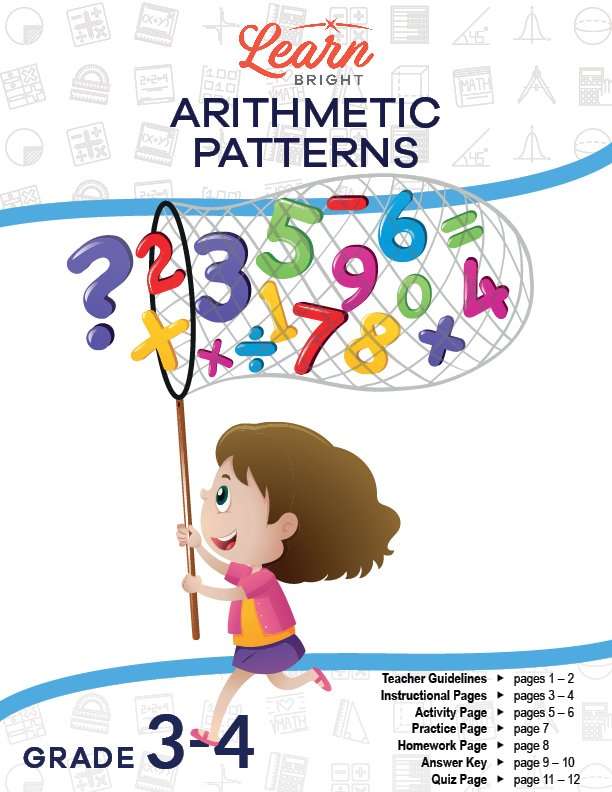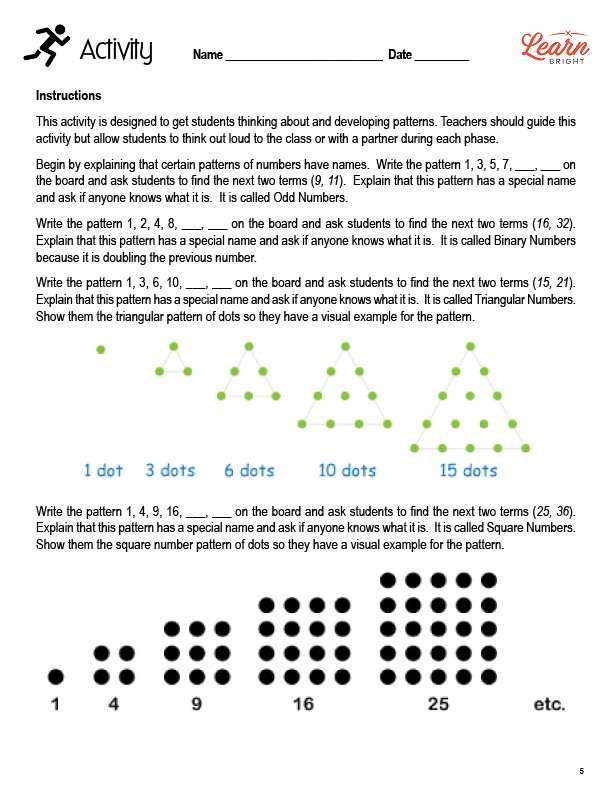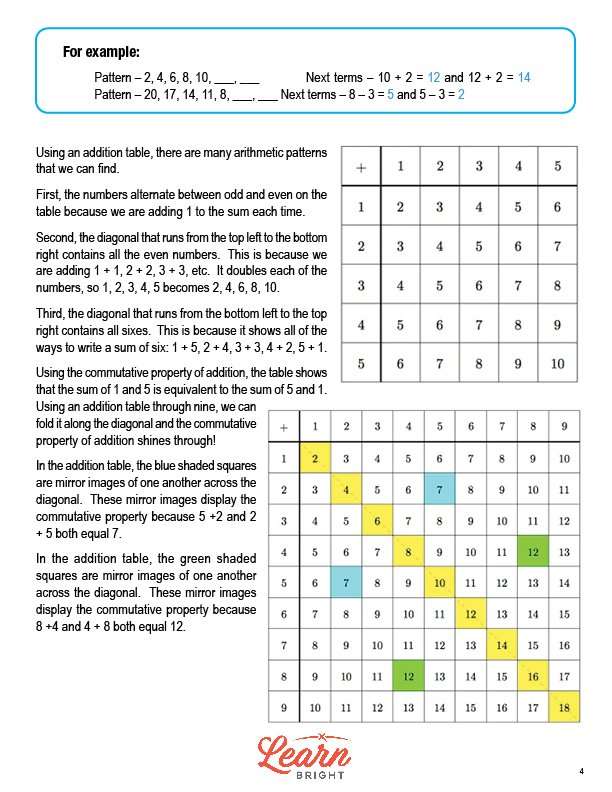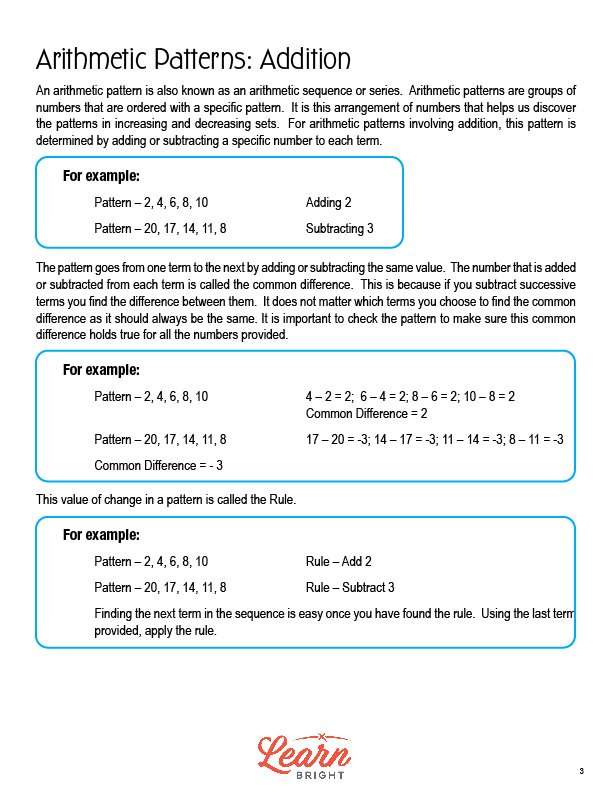Description
What our Arithmetic Patterns lesson plan includes
Lesson Objectives and Overview: Arithmetic Patterns introduces students to arithmetic patterns using the addition and multiplication tables. This hands-on lesson challenges students to create arithmetic patterns for the class to solve, as well as utilizes pair groups for checking answers to sequences solved individually. At the end of the lesson, students will be able to identify and generate a number pattern that follows a specific arithmetic rule. This lesson is for students in 3rd grade and 4th grade.
Classroom Procedure
Every lesson plan provides you with a classroom procedure page that outlines a step-by-step guide to follow. You do not have to follow the guide exactly. The guide helps you organize the lesson and details when to hand out worksheets. It also lists information in the blue box that you might find useful. You will find the lesson objectives, state standards, and number of class sessions the lesson should take to complete in this area. In addition, it describes the supplies you will need as well as what and how you need to prepare beforehand. The supplies you will need for this lesson include paper and copies of addition tables.
Options for Lesson
Included with this lesson is an “Options for Lesson” section that lists a number of suggestions for activities to add to the lesson or substitutions for the ones already in the lesson. One optional addition to the lesson is to have your students create their own problems for solving. You can also pose a Fibonacci sequence for students as an extension of the lesson. Finally, you can have your students create word problems about sequences.
Teacher Notes
The teacher notes page includes lines that you can use to add your own notes as you’re preparing for this lesson.
ARITHMETIC PATTERNS LESSON PLAN CONTENT PAGES
Arithmetic Patterns: Addition
The Arithmetic Patterns lesson plan includes two pages of content. Arithmetic patterns, also known as arithmetic sequences or series, are groups of numbers ordered with a specific pattern. By looking at the arrangement of numbers, we can discover the patterns in increasing and decreasing sets. If it’s an arithmetic pattern that involves addition, we can find the pattern by adding or subtracting a specific number to each term.
For the pattern 2, 4, 6, 8, 10, we add 2. For the pattern 20, 17, 14, 11, 8, we subtract 3. The pattern goes from one term to the next by adding or subtracting the same value. We call this value the common difference, because the difference between each term is the same, no matter which terms you’re comparing. It’s important to pay attention and make sure the common difference holds true for all of the terms. For the pattern 2, 4, 6, 8, 10, the common difference is 2 (4 – 2 = 2, 6 -4 = 2, 8 – 6 = 2, and 10 – 8 = 2).
We call the value of change in a pattern the rule. For the pattern 2, 4, 6, 8, 10, the rule is that we add 2. We can find the next terms in the sequence by following the rule. The next two terms in this sequence would be 12 and 14, because 10 + 2 = 12 and 12 + 2 = 24.
Addition Tables
We can find many arithmetic patterns using an addition table. The numbers alternate between odd and even because we add 1 each time. Looking at the table on a diagonal from top left to bottom right, we see all even numbers because we’re doubling each of the numbers. Looking at it from bottom left to top right, we see all 6s because it shows all the ways to write a sum of 6.
Because of the commutative property of addition, these tables show that the sums of two digits are the same no matter which order you add them in. If we look at an addition table through nine and fold it along the diagonal and see the commutative property in action. In the example addition table printed in the lesson, the 7s and 12s are highlighted. They are mirror images of each other and display the commutative property.
ARITHMETIC PATTERNS LESSON PLAN WORKSHEETS
The Arithmetic Patterns lesson plan includes four worksheets: an activity worksheets, a practice worksheet, a homework assignment, and a quiz. You can refer to the guide on the classroom procedure page to determine when to hand out each worksheet.
GUIDED ACTIVITY WORKSHEET
The teacher-guided lesson activity gets students thinking about and developing patterns. The teacher will start by explaining that some specific number patterns have names. They will demonstrate that odd numbers, event numbers, triangular numbers, and square numbers are all number patterns! Teachers should use visual aids to demonstrate each number pattern.
The next part of the activity is called the Handshake Puzzle. It asks students to imagine nine players on a basketball team. At the end of the game, each player shakes hands with each of the other players exactly once. After students have tried solving this problem, the teacher will demonstrate the answer by having students shake hands with each other. With each additional player (student) added, the number of handshakes increases at a predictable rate. This is another example of a number pattern!
EXAMINE THE PATTERN PRACTICE WORKSHEET
The practice worksheet asks students to examine number patterns and figure out the next three numbers in the pattern. They will also identify the rule for each number pattern.
ARITHMETIC PATTERNS HOMEWORK ASSIGNMENT
For the homework assignment, students will create three arithmetic pattern problems, writing down the next three items and the rule. They will swap papers with another student. Each student will solve someone else’s problems.
QUIZ
This lesson includes a quiz that you can use to test students’ understanding of the lesson material. For the quiz, students will first examine several number patterns and figure out the next three numbers in the pattern. They will also identify the rule for the number pattern. Students will also name one pattern in the given table that the lesson discussed.
Worksheet Answer Keys
This lesson plan includes answer keys for the practice worksheet, the homework assignment, and the quiz. If you choose to administer the lesson pages to your students via PDF, you will need to save a new file that omits these pages. Otherwise, you can simply print out the applicable pages and keep these as reference for yourself when grading assignments.









